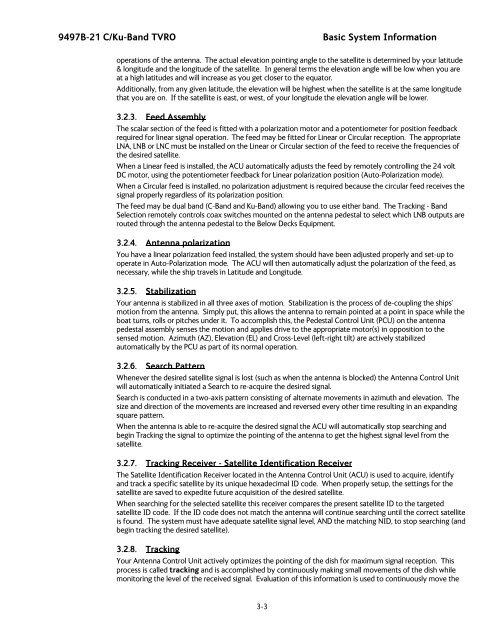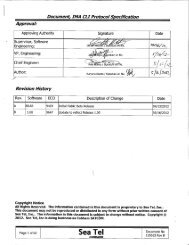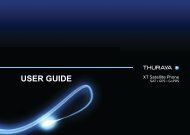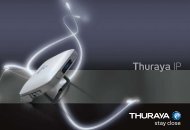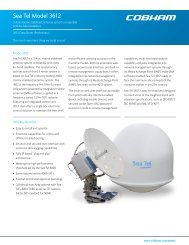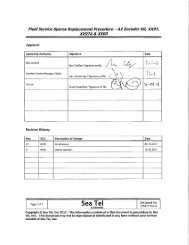User Manual Dual C or Quad Ku Band TVRO Antenna (9497B-21)
User Manual Dual C or Quad Ku Band TVRO Antenna (9497B-21)
User Manual Dual C or Quad Ku Band TVRO Antenna (9497B-21)
- No tags were found...
You also want an ePaper? Increase the reach of your titles
YUMPU automatically turns print PDFs into web optimized ePapers that Google loves.
<strong>9497B</strong>-<strong>21</strong> C/<strong>Ku</strong>-<strong>Band</strong> <strong>TVRO</strong> Basic System Inf<strong>or</strong>mationoperations of the antenna. The actual elevation pointing angle to the satellite is determined by your latitude& longitude and the longitude of the satellite. In general terms the elevation angle will be low when you areat a high latitudes and will increase as you get closer to the equat<strong>or</strong>.Additionally, from any given latitude, the elevation will be highest when the satellite is at the same longitudethat you are on. If the satellite is east, <strong>or</strong> west, of your longitude the elevation angle will be lower.3.2.3. Feed AssemblyThe scalar section of the feed is fitted with a polarization mot<strong>or</strong> and a potentiometer f<strong>or</strong> position feedbackrequired f<strong>or</strong> linear signal operation. The feed may be fitted f<strong>or</strong> Linear <strong>or</strong> Circular reception. The appropriateLNA, LNB <strong>or</strong> LNC must be installed on the Linear <strong>or</strong> Circular section of the feed to receive the frequencies ofthe desired satellite.When a Linear feed is installed, the ACU automatically adjusts the feed by remotely controlling the 24 voltDC mot<strong>or</strong>, using the potentiometer feedback f<strong>or</strong> Linear polarization position (Auto-Polarization mode).When a Circular feed is installed, no polarization adjustment is required because the circular feed receives thesignal properly regardless of its polarization position.The feed may be dual band (C-<strong>Band</strong> and <strong>Ku</strong>-<strong>Band</strong>) allowing you to use either band. The Tracking - <strong>Band</strong>Selection remotely controls coax switches mounted on the antenna pedestal to select which LNB outputs arerouted through the antenna pedestal to the Below Decks Equipment.3.2.4. <strong>Antenna</strong> polarizationYou have a linear polarization feed installed, the system should have been adjusted properly and set-up tooperate in Auto-Polarization mode. The ACU will then automatically adjust the polarization of the feed, asnecessary, while the ship travels in Latitude and Longitude.3.2.5. StabilizationYour antenna is stabilized in all three axes of motion. Stabilization is the process of de-coupling the ships’motion from the antenna. Simply put, this allows the antenna to remain pointed at a point in space while theboat turns, rolls <strong>or</strong> pitches under it. To accomplish this, the Pedestal Control Unit (PCU) on the antennapedestal assembly senses the motion and applies drive to the appropriate mot<strong>or</strong>(s) in opposition to thesensed motion. Azimuth (AZ), Elevation (EL) and Cross-Level (left-right tilt) are actively stabilizedautomatically by the PCU as part of its n<strong>or</strong>mal operation.3.2.6. Search PatternWhenever the desired satellite signal is lost (such as when the antenna is blocked) the <strong>Antenna</strong> Control Unitwill automatically initiated a Search to re-acquire the desired signal.Search is conducted in a two-axis pattern consisting of alternate movements in azimuth and elevation. Thesize and direction of the movements are increased and reversed every other time resulting in an expandingsquare pattern.When the antenna is able to re-acquire the desired signal the ACU will automatically stop searching andbegin Tracking the signal to optimize the pointing of the antenna to get the highest signal level from thesatellite.3.2.7. Tracking Receiver - Satellite Identification ReceiverThe Satellite Identification Receiver located in the <strong>Antenna</strong> Control Unit (ACU) is used to acquire, identifyand track a specific satellite by its unique hexadecimal ID code. When properly setup, the settings f<strong>or</strong> thesatellite are saved to expedite future acquisition of the desired satellite.When searching f<strong>or</strong> the selected satellite this receiver compares the present satellite ID to the targetedsatellite ID code. If the ID code does not match the antenna will continue searching until the c<strong>or</strong>rect satelliteis found. The system must have adequate satellite signal level, AND the matching NID, to stop searching (andbegin tracking the desired satellite).3.2.8. TrackingYour <strong>Antenna</strong> Control Unit actively optimizes the pointing of the dish f<strong>or</strong> maximum signal reception. Thisprocess is called tracking and is accomplished by continuously making small movements of the dish whilemonit<strong>or</strong>ing the level of the received signal. Evaluation of this inf<strong>or</strong>mation is used to continuously move the3-3


